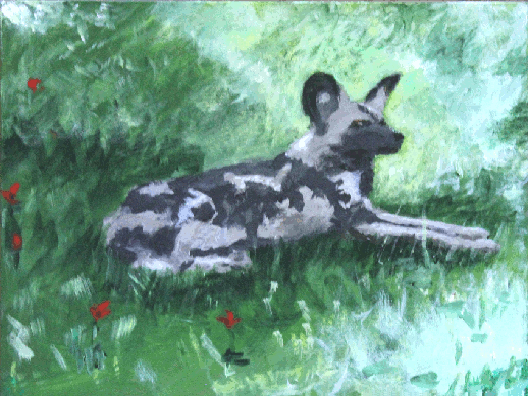African Wild Dog

We've been told that dogs and wolves are canis lupus. So you might expect that so are the African wild dogs. I mean, a dog's a dog, yes?
Uh, not quite. In the olden days the domesticated dog - long called man's best friend - was canis familiaris and the wolves were canis lupus. But now the familiaris and lupus names are considered to be subspecies. So dogs and wolves are canis lupus familiaris and canis lupus lupus.
Instead the African wild dog is Lycaon pictus. So we see that African wild dogs aren't even in the same genus as dogs and wolves. However all three have 78 chromosomes and a popular informational website mentions there is potential interbreeding. In general this means given the right opportunity they might but given their circumstances don't.
The African wild dogs are fairly good size - average weight is about 50 pounds. They also hunt in packs and can bring down large animals like the kudu, wildebeests, and other antelopes. Of course, they also will hunt down smaller prey where a pack may not be needed.
The species has been around for around 200,000 years which means they were around with Neanderthals and before early modern humans. With such a long lineage it's not surprising that African wild dogs have become part of the oral history and legends of indigenous African peoples. Today, though, it's best to keep your distance if you're visiting Africa - advice that goes when seeing all the other wild animals.
Although there are many representations of different dog breeds in Ancient Egyptian art, they are ancestors of the domesticated dogs, not the African wild dog. The Egyptian dogs seemed to be the Basenji, Greyhound, or Saluki or a not too distant ancestor. There's even some pictures of what look like dachshunds - often referred to in Quaint Regions in America as the "wiener dog". The Egyptian god Anubis was long referred to as a jackal headed god (and sometimes still is). But in the 1960's the Egyptologist Christiane Desroches Noblecourt specifically referred to Anubis as a dog.
The Egyptians had a number of words for dog. The general term (which we would just call a "dog") is . What seems strange to those new to the language is that the first picture is of a newborn calf. But the hieroglyphs represent sounds and may have nothing to do with the actual picture. That's like representing the English word "belief" by a picture of a bee and a leaf.
The sound of the symbol is represented as "yw" in the modern transliteration conventions with alternative representations as "iw" "jw" or (an older rendering) as "au". So the word for dog may have been spoken something like "yew" or "aw".
The picture of the quail chick is a phonetic complement to reinforce the understanding that the last sound is a "w" or "u". The picture of the dog at the end is a determinative, a picture to show the reader the word isn't about a calf or a quail chick but about a dog.
It may seem strange that the picture of a calf is used for the word for dog but the Ancient Egyptian word for "son" - a male child - is "sa" and was a picture of a duck, where the picture of the person is the determinative and indicates the word means "son" and not "duck".
The apparent inconsistencies in the modern academic transliteration and the (possibly) spoken word can be understood in that the Ancient Egyptian language, like others, underwent changes over the course of its history. For instance, the name of the famous Pharaoh Tutankhamun is transliterated as "twt-'nk-imn", "twt-'nk-ymn", or "twt-'nk-jmn" but in Tut's time it was almost certainly pronounced like "toot-ankh-ah-moon".
As are so many animals, the African wild dog is considered endangered by the International Union for Conservation of Nature. Some estimates are that there are fewer than 5000 of the adult animals in the wild.
References
"African Wild Dogs", Victor Gentle and Janet Perry, Stevens Publishing, 2001.
"Running Wild: Dispelling the Myths of the African Wild Dog", John McNutt, Lesley Boggs, Helene Heldring, and Dave Hamman, Smithsonian Institution Press, 1997.
"African Wild Dog", A-Z Animal Facts.
"African Wild Dog", World Wildlife Federation.
"African Wild Dog", African Wildlife Fund.
"African Wild Dog", National Geographic.
"Dogs in Ancient Egypt", Joshua Mark, World History Encyclopedia.
Tutankhamen: Life and Death of a Pharaoh, Christiane Desroches Noblecourt, New York Graphic Society, 1963.
"The Dogs of Ancient Egypt", Jimmy Dunn, Tour Egypt.
"Chromosome Number of Various Animals", Bank of Biology, February 18, 2012.